TOYOTA SEQUOIA HYBRID 2023 Owners Manual
Manufacturer: TOYOTA, Model Year: 2023, Model line: SEQUOIA HYBRID, Model: TOYOTA SEQUOIA HYBRID 2023Pages: 628, PDF Size: 14.27 MB
Page 141 of 628
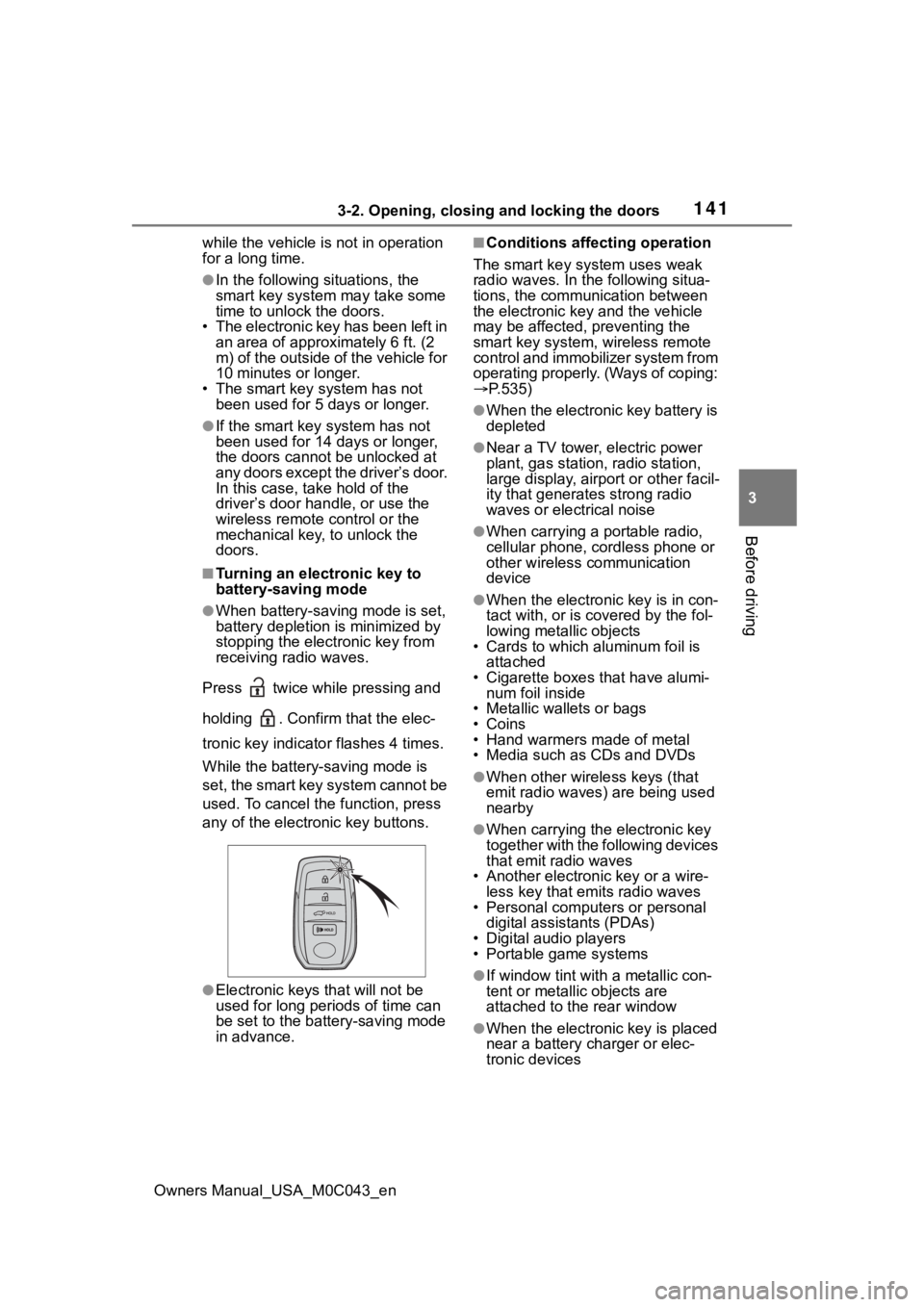
1413-2. Opening, closing and locking the doors
Owners Manual_USA_M0C043_en
3
Before driving
while the vehicle is not in operation
for a long time.
●In the following situations, the
smart key system may take some
time to unlock the doors.
• The electronic key has been left in an area of approximately 6 ft. (2
m) of the outside of the vehicle for
10 minutes or longer.
• The smart key system has not been used for 5 days or longer.
●If the smart key system has not
been used for 14 days or longer,
the doors canno t be unlocked at
any doors except the driver’s door.
In this case, take hold of the
driver’s door handle, or use the
wireless remote control or the
mechanical key, to unlock the
doors.
■Turning an electronic key to
battery-saving mode
●When battery-saving mode is set,
battery depletion is minimized by
stopping the electronic key from
receiving radio waves.
Press twice while pressing and
holding . Confirm that the elec-
tronic key indicator flashes 4 times.
While the battery-saving mode is
set, the smart key system cannot be
used. To cancel the function, press
any of the electronic key buttons.
●Electronic keys that will not be
used for long periods of time can
be set to the battery-saving mode
in advance.
■Conditions affecting operation
The smart key system uses weak
radio waves. In the following situa-
tions, the communication between
the electronic key and the vehicle
may be affected, preventing the
smart key system, wireless remote
control and immobilizer system from
operating properly. (Ways of coping:
P.535)
●When the electronic key battery is
depleted
●Near a TV tower, electric power
plant, gas station, radio station,
large display, airpo rt or other facil-
ity that generates strong radio
waves or electrical noise
●When carrying a portable radio,
cellular phone, cordless phone or
other wireless communication
device
●When the electronic key is in con-
tact with, or is c overed by the fol-
lowing metallic objects
• Cards to which aluminum foil is
attached
• Cigarette boxes that have alumi- num foil inside
• Metallic wallets or bags
•Coins
• Hand warmers made of metal
• Media such as CDs and DVDs
●When other wirel ess keys (that
emit radio waves) are being used
nearby
●When carrying the electronic key
together with the following devices
that emit radio waves
• Another electronic key or a wire- less key that emits radio waves
• Personal computers or personal
digital assistants (PDAs)
• Digital audio players
• Portable game systems
●If window tint wit h a metallic con-
tent or metallic objects are
attached to the rear window
●When the electronic key is placed
near a battery charger or elec-
tronic devices
Page 142 of 628

1423-2. Opening, closing and locking the doors
Owners Manual_USA_M0C043_en
●When the vehicle is parked in a
pay parking spot where radio
waves are emitted.
■Note for the entry function
●Even when the electronic key is
within the effective range (detec-
tion areas), the system may not
operate properly in the following
cases:
• The electronic key is too close to the window or outside door han-
dle, near the ground, or in a high
place when the doors are locked
or unlocked.
• The electronic key is near the
ground or in a high place, or too
close to the center of the rear
bumper.
• The electronic key is on the instru- ment panel, or floor, or in the door
pockets or glove box when the
hybrid system is s tarted or power
switch modes are changed.
●Do not leave the electronic key on
top of the instrument panel or near
the door pockets when exiting the
vehicle. Depending on the radio
wave reception conditions, it may
be detected by the antenna out-
side the cabin and the doors will
become lockable from the outside,
possibly trapping the electronic
key inside the vehicle.
●As long as the electronic key is
within the effective range, the
doors may be locked or unlocked
by anyone. However, only the
doors detecting the electronic key
can be used to unl ock the vehicle.
●Even if the electronic key is not
inside the vehicle, it may be possi-
ble to start the hybrid system if the
electronic key is near the window.
●The doors may unlock or lock if a
large amount of water splashes on
the door handle, such as in the
rain or in a car wash, when the
electronic key is within the effec-
tive range. (The doors will auto-
matically be locked after
approximately 60 seconds if the doors or the glass hatch are not
opened and closed.)
●If the wireless remote control is
used to lock the doors when the
electronic key is near the vehicle,
there is a possib
ility that the door
may not be unlocked by the entry
function. (Use the wireless remote
control to unlock the doors.)
●Touching the door lock sensor
while wearing gloves may delay or
prevent lock operation.
●When the lock operation is per-
formed using the lock sensor, rec-
ognition signals will be shown up
to two consecutive times. After
this, no recognition signals will be
given.
●If the door handle becomes wet
while the electronic key is within
the effective range, the door may
lock and unlock repeatedly. In this
case, follow the following correc-
tion procedures to wash the vehi-
cle:
• Place the electronic key in a loca-
tion 6 ft. (2 m) or more away from
the vehicle. (Take care to ensure
that the key is not stolen.)
• Set the electronic key to battery- saving mode to disable the smart
key system. ( P.141)
●If the electronic key is inside the
vehicle and a door handle
becomes wet during a car wash, a
message may be shown on the
multi-information display and a
buzzer will sound outside the vehi-
cle. To turn off the alarm, lock all
the doors.
●The lock sensor may not work
properly if it comes into contact
with ice, snow, m ud, etc. Clean
the lock sensor and attempt to
operate it again.
●A sudden approach to the effec-
tive range or door handle may pre-
vent the doors from being
unlocked. In this case, return the
door handle to the original position
and check that t he doors unlock
Page 143 of 628
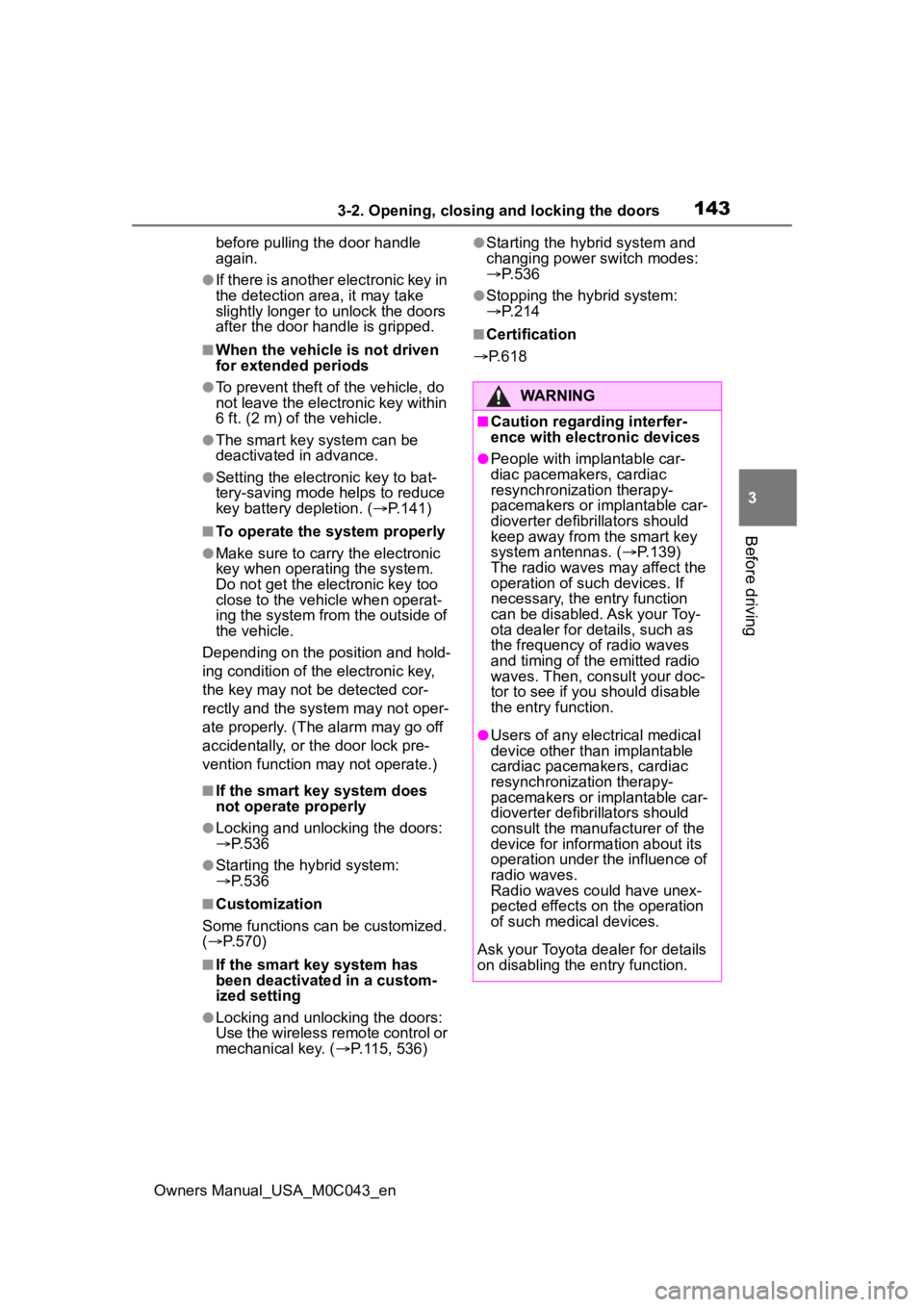
1433-2. Opening, closing and locking the doors
Owners Manual_USA_M0C043_en
3
Before driving
before pulling the door handle
again.
●If there is another electronic key in
the detection area, it may take
slightly longer to unlock the doors
after the door handle is gripped.
■When the vehicle is not driven
for extended periods
●To prevent theft of the vehicle, do
not leave the electronic key within
6 ft. (2 m) of the vehicle.
●The smart key system can be
deactivated in advance.
●Setting the electronic key to bat-
tery-saving mode helps to reduce
key battery depletion. ( P.141)
■To operate the system properly
●Make sure to carry the electronic
key when operating the system.
Do not get the electronic key too
close to the vehicle when operat-
ing the system from the outside of
the vehicle.
Depending on the position and hold-
ing condition of the electronic key,
the key may not be detected cor-
rectly and the system may not oper-
ate properly. (The alarm may go off
accidentally, or the door lock pre-
vention function may not operate.)
■If the smart key system does
not operate properly
●Locking and unlocking the doors:
P. 5 3 6
●Starting the hybrid system:
P. 5 3 6
■Customization
Some functions can be customized.
( P.570)
■If the smart key system has
been deactivated in a custom-
ized setting
●Locking and unlocking the doors:
Use the wireless remote control or
mechanical key. ( P.115, 536)
●Starting the hybrid system and
changing power switch modes:
P. 5 3 6
●Stopping the hybrid system:
P. 2 1 4
■Certification
P.618
WARNING
■Caution regarding interfer-
ence with electronic devices
●People with implantable car-
diac pacemakers, cardiac
resynchronization therapy-
pacemakers or implantable car-
dioverter defibrillators should
keep away from the smart key
system antennas. ( P.139)
The radio waves may affect the
operation of such devices. If
necessary, the entry function
can be disabled. Ask your Toy-
ota dealer for details, such as
the frequency of radio waves
and timing of the emitted radio
waves. Then, consult your doc-
tor to see if you should disable
the entry function.
●Users of any electrical medical
device other than implantable
cardiac pacemakers, cardiac
resynchronization therapy-
pacemakers or implantable car-
dioverter defibrillators should
consult the manufacturer of the
device for information about its
operation under the influence of
radio waves.
Radio waves could have unex-
pected effects on the operation
of such medical devices.
Ask your Toyota dealer for details
on disabling the entry function.
Page 144 of 628
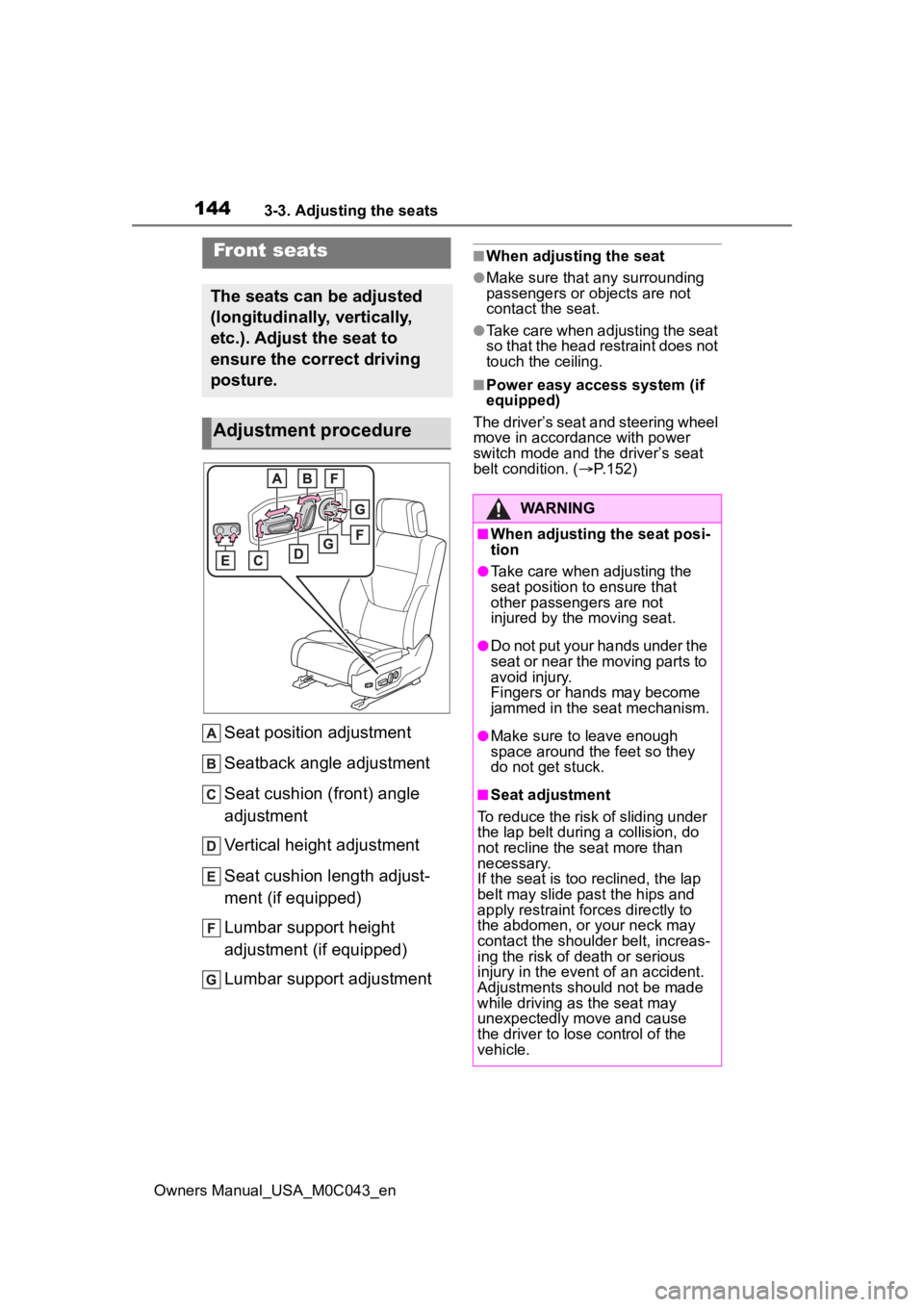
1443-3. Adjusting the seats
Owners Manual_USA_M0C043_en
3-3.Adjusting the seats
Seat position adjustment
Seatback angle adjustment
Seat cushion (front) angle
adjustment
Vertical height adjustment
Seat cushion length adjust-
ment (if equipped)
Lumbar support height
adjustment (if equipped)
Lumbar support adjustment
■When adjusting the seat
●Make sure that any surrounding
passengers or objects are not
contact the seat.
●Take care when adjusting the seat
so that the head restraint does not
touch the ceiling.
■Power easy access system (if
equipped)
The driver’s seat and steering wheel
move in accordance with power
switch mode and th e driver’s seat
belt condition. ( P.152)
Front seats
The seats can be adjusted
(longitudinally, vertically,
etc.). Adjust the seat to
ensure the correct driving
posture.
Adjustment procedure
WARNING
■When adjusting the seat posi-
tion
●Take care when adjusting the
seat position to ensure that
other passengers are not
injured by the moving seat.
●Do not put your hands under the
seat or near the moving parts to
avoid injury.
Fingers or hands may become
jammed in the seat mechanism.
●Make sure to leave enough
space around the feet so they
do not get stuck.
■Seat adjustment
To reduce the risk of sliding under
the lap belt during a collision, do
not recline the se at more than
necessary.
If the seat is too reclined, the lap
belt may slide past the hips and
apply restraint for ces directly to
the abdomen, or your neck may
contact the shoulder belt, increas-
ing the risk of death or serious
injury in the event of an accident.
Adjustments should not be made
while driving as the seat may
unexpectedly move and cause
the driver to lose control of the
vehicle.
Page 145 of 628
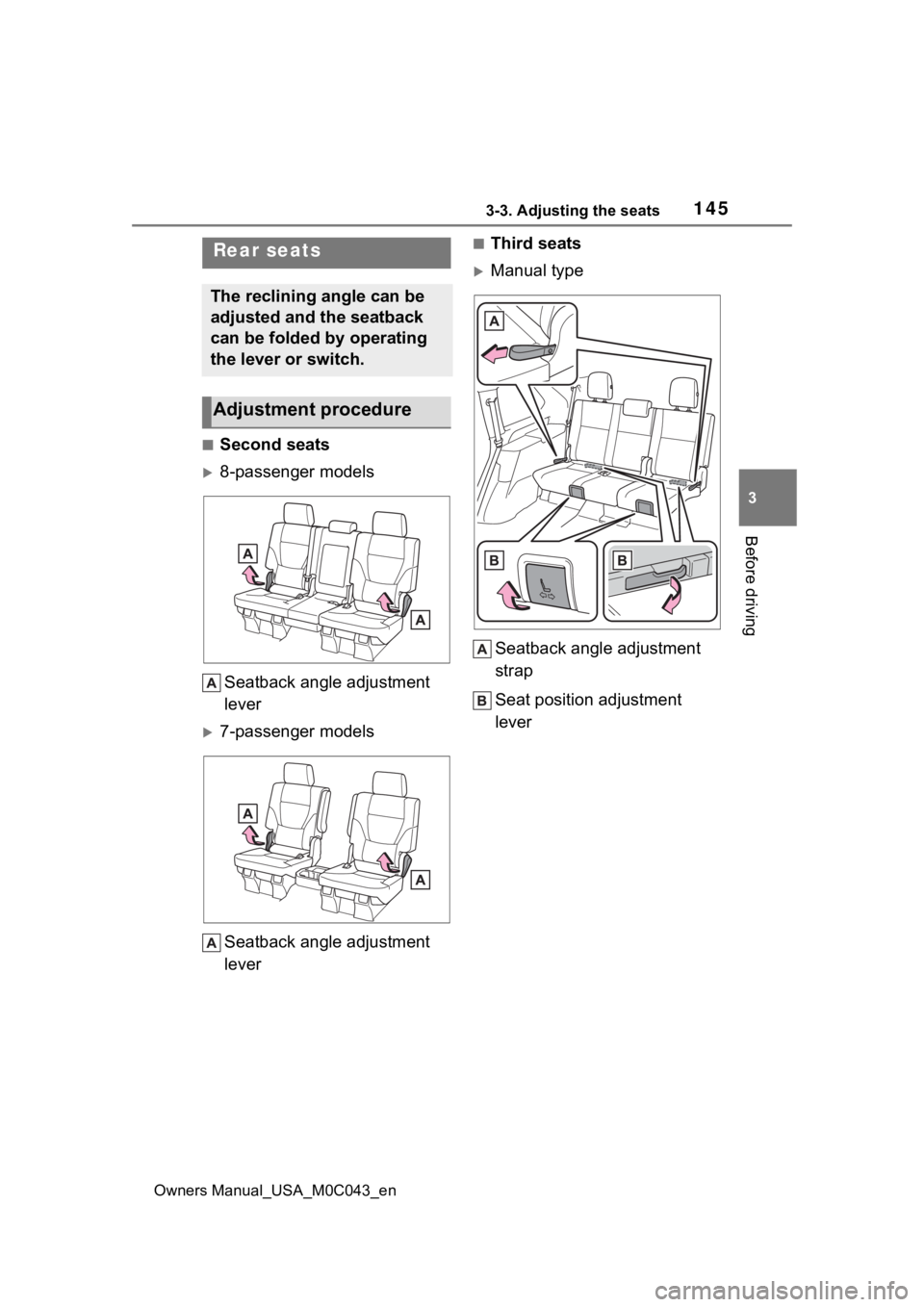
1453-3. Adjusting the seats
Owners Manual_USA_M0C043_en
3
Before driving
■Second seats
8-passenger models Seatback angle adjustment
lever
7-passenger modelsSeatback angle adjustment
lever
■Third seats
Manual type
Seatback angle adjustment
strap
Seat position adjustment
lever
Rear seats
The reclining angle can be
adjusted and the seatback
can be folded by operating
the lever or switch.
Adjustment procedure
Page 146 of 628
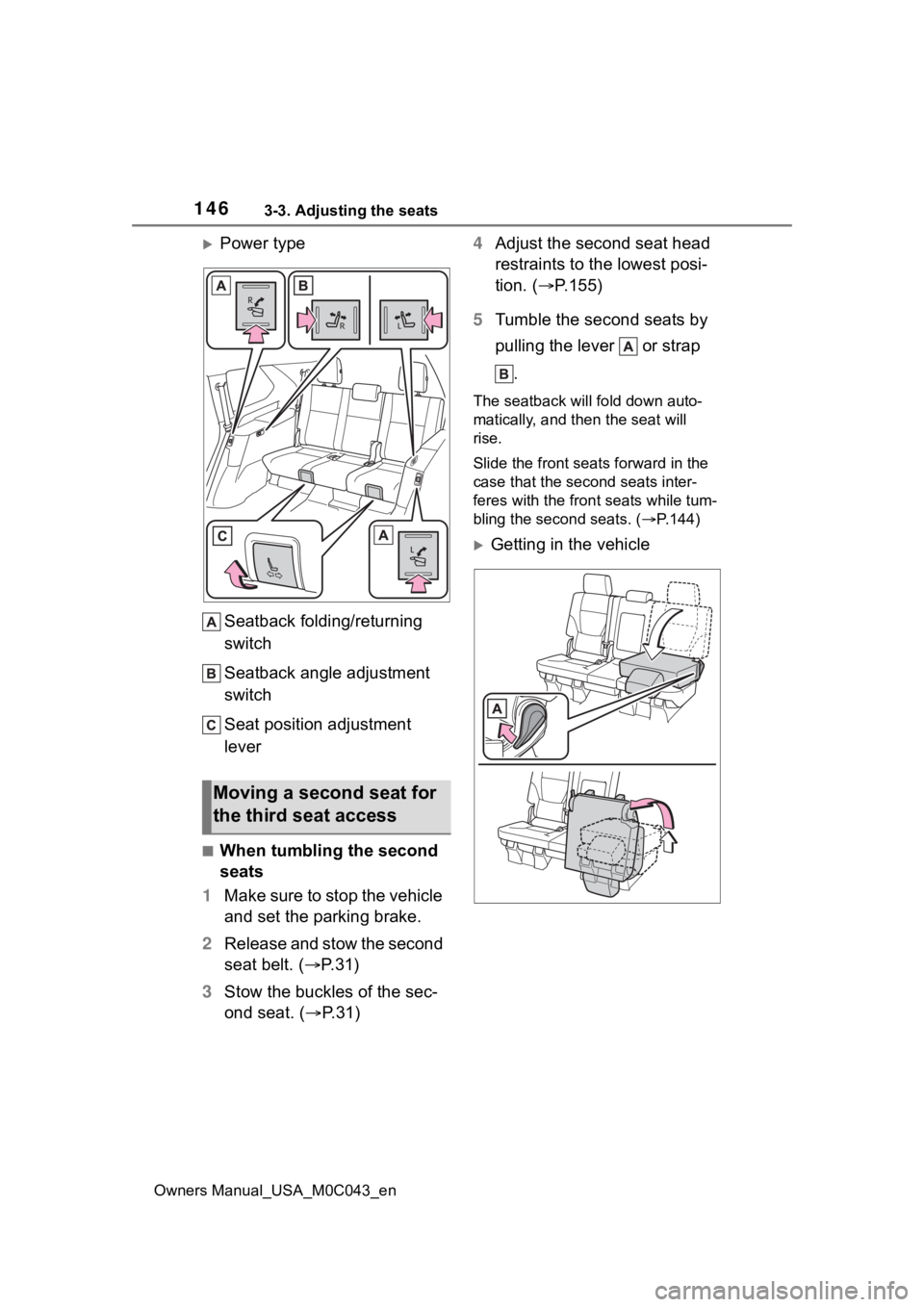
1463-3. Adjusting the seats
Owners Manual_USA_M0C043_en
Power typeSeatback folding/returning
switch
Seatback angle adjustment
switch
Seat position adjustment
lever
■When tumbling the second
seats
1 Make sure to stop the vehicle
and set the parking brake.
2 Release and stow the second
seat belt. ( P. 3 1 )
3 Stow the buckles of the sec-
ond seat. ( P.31) 4
Adjust the second seat head
restraints to the lowest posi-
tion. ( P.155)
5 Tumble the second seats by
pulling the lever or strap
.
The seatback will fold down auto-
matically, and then the seat will
rise.
Slide the front seat s forward in the
case that the second seats inter-
feres with the fron t seats while tum-
bling the second seats. ( P.144)
Getting in the vehicle
Moving a second seat for
the third seat access
Page 147 of 628

1473-3. Adjusting the seats
Owners Manual_USA_M0C043_en
3
Before driving
Getting out of the vehicle
■When returning the second
seats to the original posi-
tion.
1 Make sure to stop the vehicle
and set the parking brake.
( P.222)
2 Secure the second seat
Slowly press the seat legs located
at the rear end of the second seat
onto the locking position , and
securely latch them to the floor.
3Return the seatback
WARNING
■When adjusting the seat posi-
tion
●Take care when adjusting the
seat position to ensure that
other passengers are not
injured by the moving seat.
●Be careful that the seat does
not hit a passenger or luggage.
●Do not put your hands under the
seat or near the moving parts to
avoid injury.
Fingers or hands may become
jammed in the seat mechanism.
●Do not adjusting the seat posi-
tion while the veh icle is moving.
■Seat adjustment
After adjusting the seat, make
sure that the seat is locked in
position.
■When getting in and out of
the vehicle from the third
seats
●Secure the seco nd seat after
getting in and out of the third
seat.
●Do not allow anyone to put their
hands in the movable parts,
connected parts or the seat plat-
form when adjusting the seat
position, increasing the risk of
serious injury.
Page 148 of 628
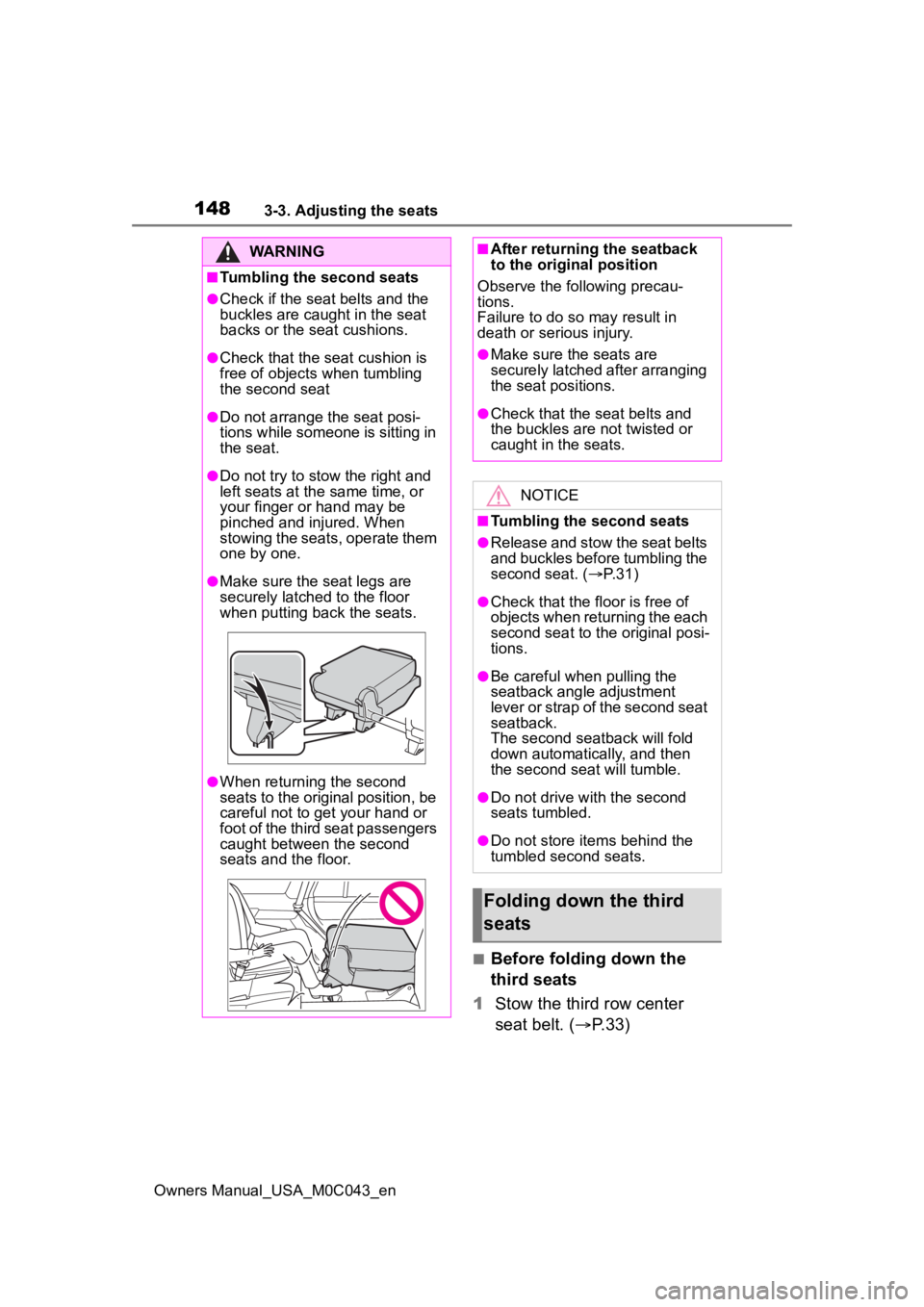
1483-3. Adjusting the seats
Owners Manual_USA_M0C043_en
■Before folding down the
third seats
1 Stow the third row center
seat belt. ( P.33)
WARNING
■Tumbling the second seats
●Check if the seat belts and the
buckles are caught in the seat
backs or the seat cushions.
●Check that the seat cushion is
free of objects when tumbling
the second seat
●Do not arrange the seat posi-
tions while someone is sitting in
the seat.
●Do not try to stow the right and
left seats at th e same time, or
your finger or hand may be
pinched and injured. When
stowing the seats, operate them
one by one.
●Make sure the seat legs are
securely latched to the floor
when putting back the seats.
●When returning the second
seats to the original position, be
careful not to get your hand or
foot of the third seat passengers
caught between the second
seats and the floor.
■After returning the seatback
to the original position
Observe the following precau-
tions.
Failure to do so may result in
death or serious injury.
●Make sure the seats are
securely latched after arranging
the seat positions.
●Check that the seat belts and
the buckles are not twisted or
caught in the seats.
NOTICE
■Tumbling the second seats
●Release and stow the seat belts
and buckles before tumbling the
second seat. ( P. 3 1 )
●Check that the floor is free of
objects when returning the each
second seat to the original posi-
tions.
●Be careful when pulling the
seatback angle adjustment
lever or strap of the second seat
seatback.
The second sea tback will fold
down automatically, and then
the second seat will tumble.
●Do not drive with the second
seats tumbled.
●Do not store items behind the
tumbled second seats.
Folding down the third
seats
Page 149 of 628
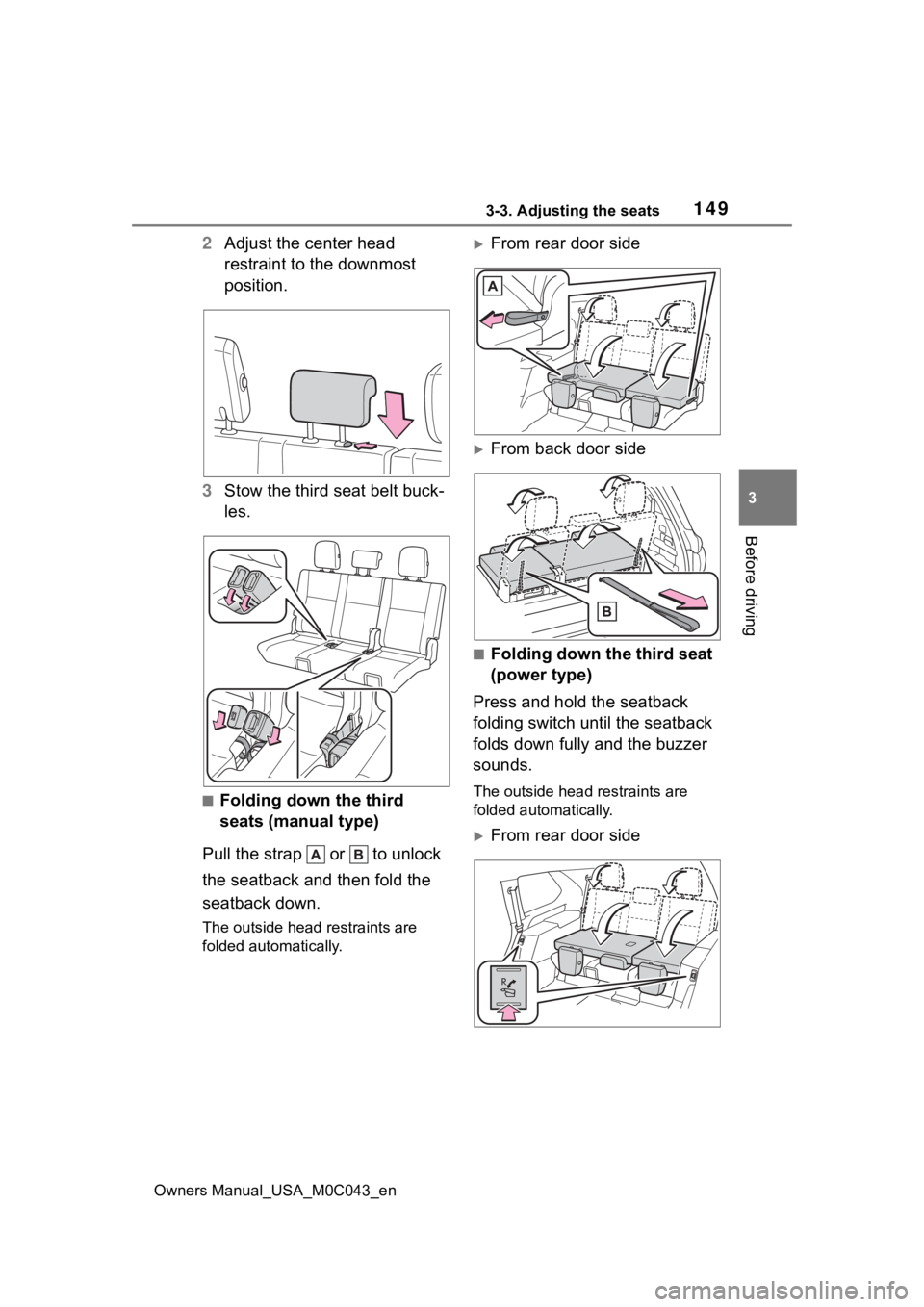
1493-3. Adjusting the seats
Owners Manual_USA_M0C043_en
3
Before driving
2 Adjust the center head
restraint to the downmost
position.
3 Stow the third seat belt buck-
les.
■Folding down the third
seats (manual type)
Pull the strap or to unlock
the seatback and then fold the
seatback down.
The outside head restraints are
folded automatically.
From rear door side
From back door side
■Folding down the third seat
(power type)
Press and hold the seatback
folding switch until the seatback
folds down fully and the buzzer
sounds.
The outside head r estraints are
folded automatically.
From rear door side
Page 150 of 628
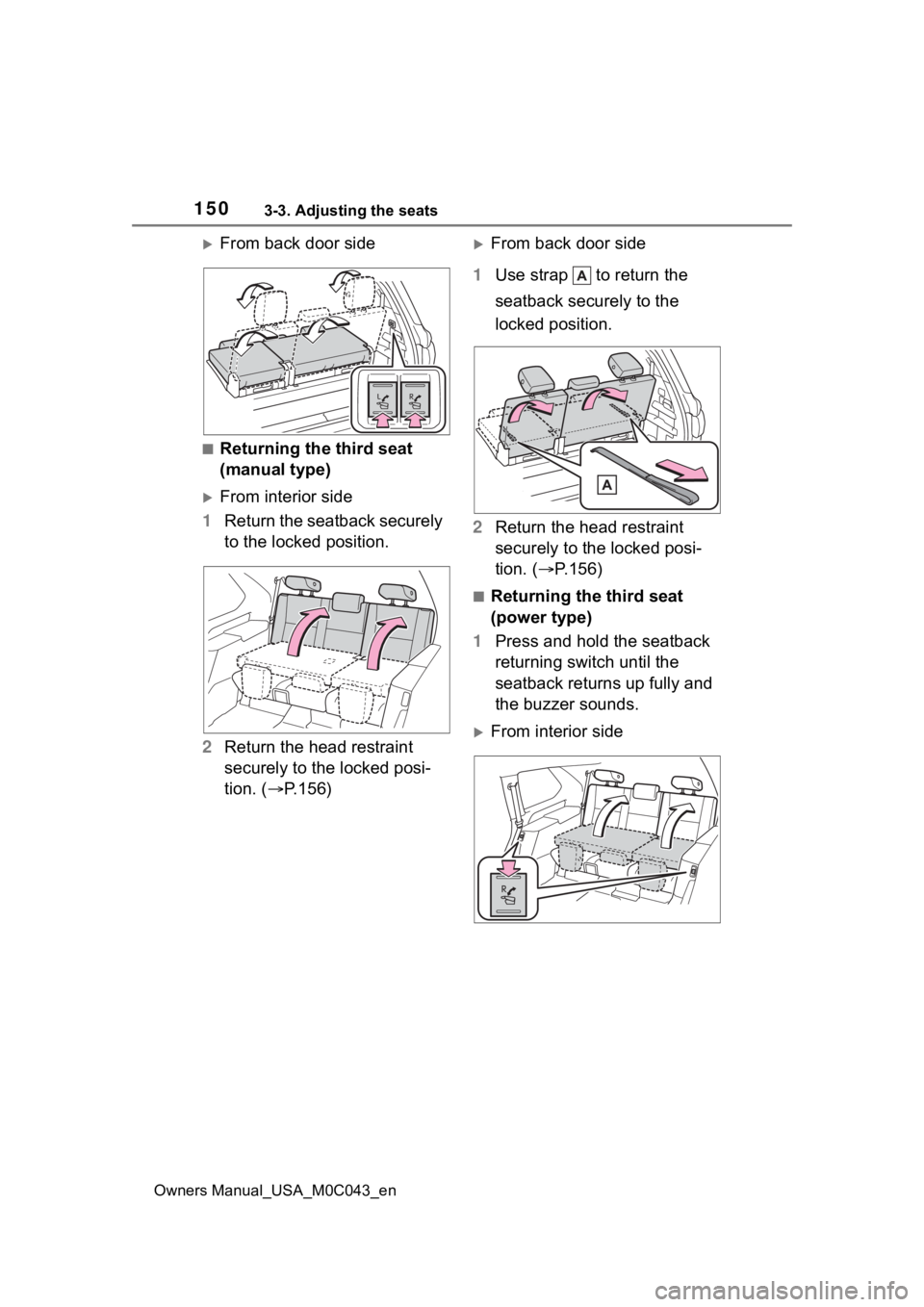
1503-3. Adjusting the seats
Owners Manual_USA_M0C043_en
From back door side
■Returning the third seat
(manual type)
From interior side
1 Return the seatback securely
to the locked position.
2 Return the head restraint
securely to the locked posi-
tion. ( P.156)
From back door side
1 Use strap to return the
seatback securely to the
locked position.
2 Return the head restraint
securely to the locked posi-
tion. ( P.156)
■Returning the third seat
(power type)
1 Press and hold the seatback
returning switch until the
seatback returns up fully and
the buzzer sounds.
From interior side